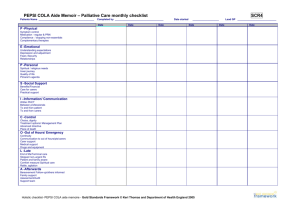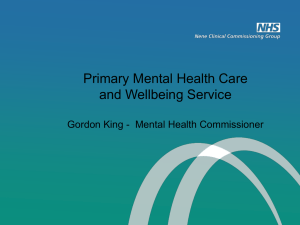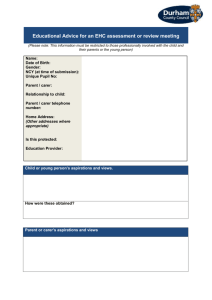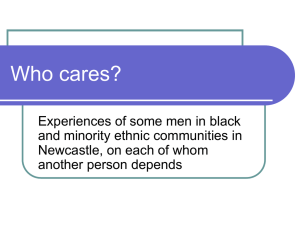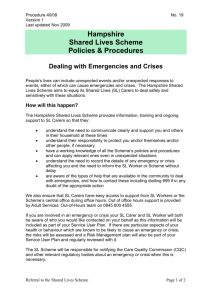Session 5-8
advertisement
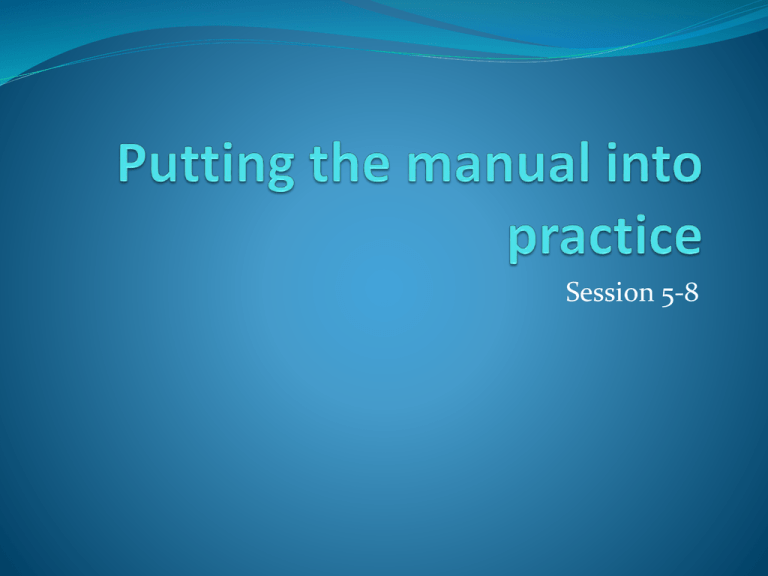
Session 5-8 Objectives for the session To revisit general themes and considerations when delivering the intervention. To consider sessions 5-8 and familiarise ourselves with the content and focus of each session. To practice delivering parts of the intervention and to reflect upon this process. To consider challenges that may occur in delivering the intervention and how to manage these challenges. Session 5 By session 5, therapists will probably have a good idea about how the carer communicates and what it may be useful to focus upon within the session. It is important to remember that we all have different communication styles depending on who we are talking to and in what context. Although there is no ‘right’ style of communicating, it can be useful with carers of people with dementia to highlight how being assertive in accessing support for themselves and their relatives can be especially effective. Session 5 cont. For the role play exercise, therapists should try to get as much information about the situation being acted out. If it feels appropriate, therapists should to challenge the carer in the role play, getting them to really persevere with asking for help and being assertive. Carers who received the intervention in the research trial reported that having some or all of the ‘tips for assertive communication’ on a list by the phone provides a helpful prompt. Many people reported finding the ‘communication with your relative’ section helpful, as almost all people will be experiencing some difficulties – even if they have not yet identified them as communication problems. Session 6 This session is about giving the person the knowledge of how and where to access additional services and support. For many carers, thinking about the future and accepting help in any form is a very sensitive issue. Try to respect the carer’s feelings and remind them that even if they are not ready to think about the future, it is useful to have the information available to them. For session 6 – we offer the carer the option to bring someone else along to the session. It is important in advance of the session to think about how you manage this, so that everyone is heard, the main carer feels supported and the session is useful. Session 6 Cont. Don’t be afraid to skip parts of this session if it will not be helpful – e.g. if the already have Lasting Power of Attorney in place. Don’t feel you have to know every service, or care option. It’s OK to say, ‘I don’t want to give you the wrong information’ – it is better to signpost or come back to them at a later date with correct information. Session 7 This session highlights how when caring role the number of pleasant activities that people engage in can significantly diminish, impacting upon mood. The biggest challenge will be for the carer to find the time and energy to do activities. Therefore the aim of the session will be to help carers recognise these barriers; and overcome these barriers through planning. Some carers will feel guilty about doing something for themselves; if so, it is important to reassure carers that this may actually help them become better carers. Be aware that pre-existing relationship between carer and patient could determine what (if any) joint activities might be acceptable to the carer. Session 8 This session is about consolidating all that you have talked about and the carer has (hopefully) learned over the last 7 sessions, and making sure they have the skills and understanding to continue using the recording techniques, skills and strategies. Many of the carers will have limited support outside of the sessions therefore it is important that they are prepared in advance that the sessions will be ending. Discuss with carers who they would approach if a problem were to arise in the future or if they need further support and if appropriate, depending upon the context of the service, signpost or refer on to another service. Putting it into practice continued... Exercise in 3s - Choose a session to role play and highlight a challenging situation (e.g. carer is very talkative). One person is interviewer, one is the caregiver, one is observer – noticing what therapist is doing that worked well. Role play delivering part of session one or two – Spend 5 – minutes at start discussing together what scenario and possible questions / ways to manage the challenge. (45 mins). Feedback – sharing ideas about what worked well / other suggestions from the group. Hearing first from the observers and then how people found interviewing / being interviewed. (20 mins) The current service context Referral received from GP via normal IAPT routes – If the referral is requesting support for carer of a person diagnosed with dementia – referral is sent by IAPT Clinical Coordinators to Penny Rapaport (PR) by email. Referral received from Memory clinic either in person during MDT or emailed to PR. If referred from memory clinic – referrer documents referral being made on Rio. Referral registered by PR onto pc mis and initially triaged for suitability for intervention. Allocated by PR to appropriate LI. LI to contact carer and complete a telephone screening interview. Not accepted for LI carer intervention. Onward referral made to appropriate service e.g. HI intervention in IAPT, Memory clinic psychologists, CMHT intervention, voluntary services. Referrer informed Referral closed on pc mis. Accepted for LI carer intervention Waiting list letter sent to client / referrer / GP and appointment letter sent at first available time At initial contact – session 1 LI to: Complete IAPT minimum data set, including risk questions. Complete IAPT PbR end of assessment PEQ (+ consent form covering this) After initial contact - session 1 LI to: Enter contact and progress note on pc mis including measures. At sessions 2-7 LI to: Complete IAPT minimum data set, including risk questions. After sessions 2-7 LI to: Enter contact and progress note on pc mis including measures. At final session LI to: Complete IAPT minimum data set, including risk questions. IAPT PbR treatment questionnaire (accompanied by the same consent form) After final session LI to: Enter contact and progress not on pc mis including measures. Ask IAPT admin staff to send out CSQ. Refer on / signpost to other services depending on need. Write discharge summary and send to referrer / GP / Client Ask supervisor to deactivate on pc mis If risk issues or safeguarding concerns are raised during intervention sessions: LI to follow existing procedures in IAPT e.g. raise safeguarding alert to Access team at Social services and / or liaise with GP with risk issues. If PR or main IAPT supervisor is unavailable, LI to contact IAPT duty senior for advice. If referral is from Memory clinic, LI to contact Memory Clinic Manager to inform of concerns and make plan. LI to document all concerns, conversations and actions on pc mis. Ongoing communication: LIs to attend Memory Clinic meetings monthly initially to ensure direct ongoing communication between services. PR to meet with Memory Clinic Managers every 3 months to review the project and identify any concerns. PR to evaluate / audit the project after 6 and 12 months Following initial training LIs will receive fortnightly specialist supervision from PR and can contact PR by phone at other times. Final thoughts…. If you have any doubts or questions when delivering the intervention speak to the person who is supervising you on the work. Clear communication and liaison with the memory services is essential, they cannot intervene if they do not know that the situation has changed or a problem has occurred. If you have any concerns about risk share this information with the memory services and your supervisor as soon as possible. Questions / learning points? ??????
